Financial Management and Control: Primetown Plc Performance Report
VerifiedAdded on 2020/01/07
|25
|5462
|190
Report
AI Summary
This report provides a comprehensive financial analysis of Primetown Plc, examining its performance from 2014 to 2015. It begins with an introduction to financial management and control, emphasizing the importance of capital for business operations. The report then presents a detailed analysis of Primetown Plc's financial statements using ratio analysis to assess profitability, liquidity, gearing, asset efficiency, and investor ratios. A key component is the calculation and interpretation of the working capital day cycle. Furthermore, the report delves into investment appraisal techniques, evaluating the viability of potential projects using methods such as Payback Period, Net Present Value (NPV), Average Rate of Return (ARR), and Internal Rate of Return (IRR). The merits and limitations of these appraisal techniques are critically assessed. The report also explores the role of budgeting in short-term decision-making and evaluates the practical implications of break-even analysis. The analysis uses figures and tables to support the findings, providing a clear picture of Primetown Plc's financial health and investment opportunities.
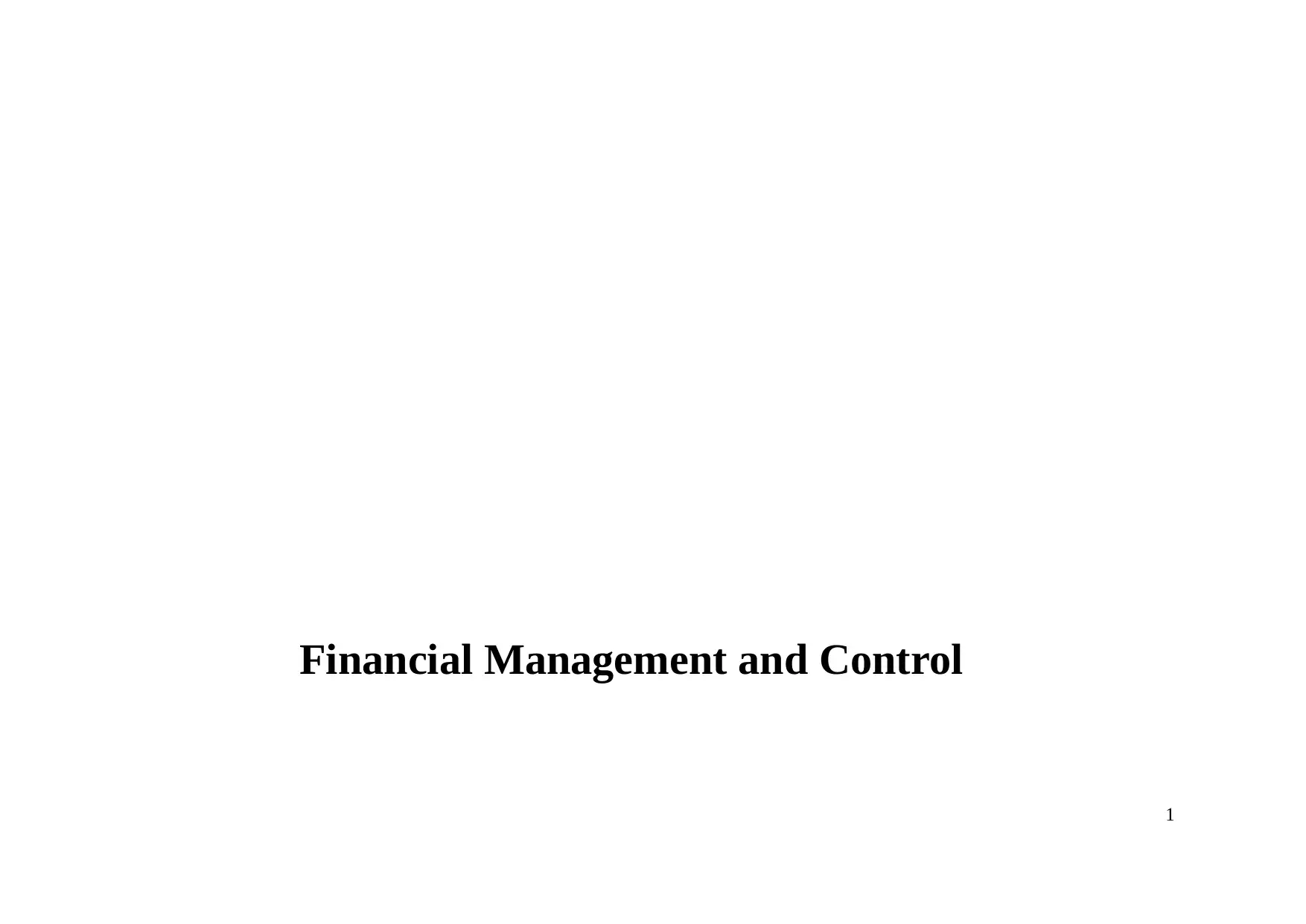
Financial Management and Control
1
1
Paraphrase This Document
Need a fresh take? Get an instant paraphrase of this document with our AI Paraphraser
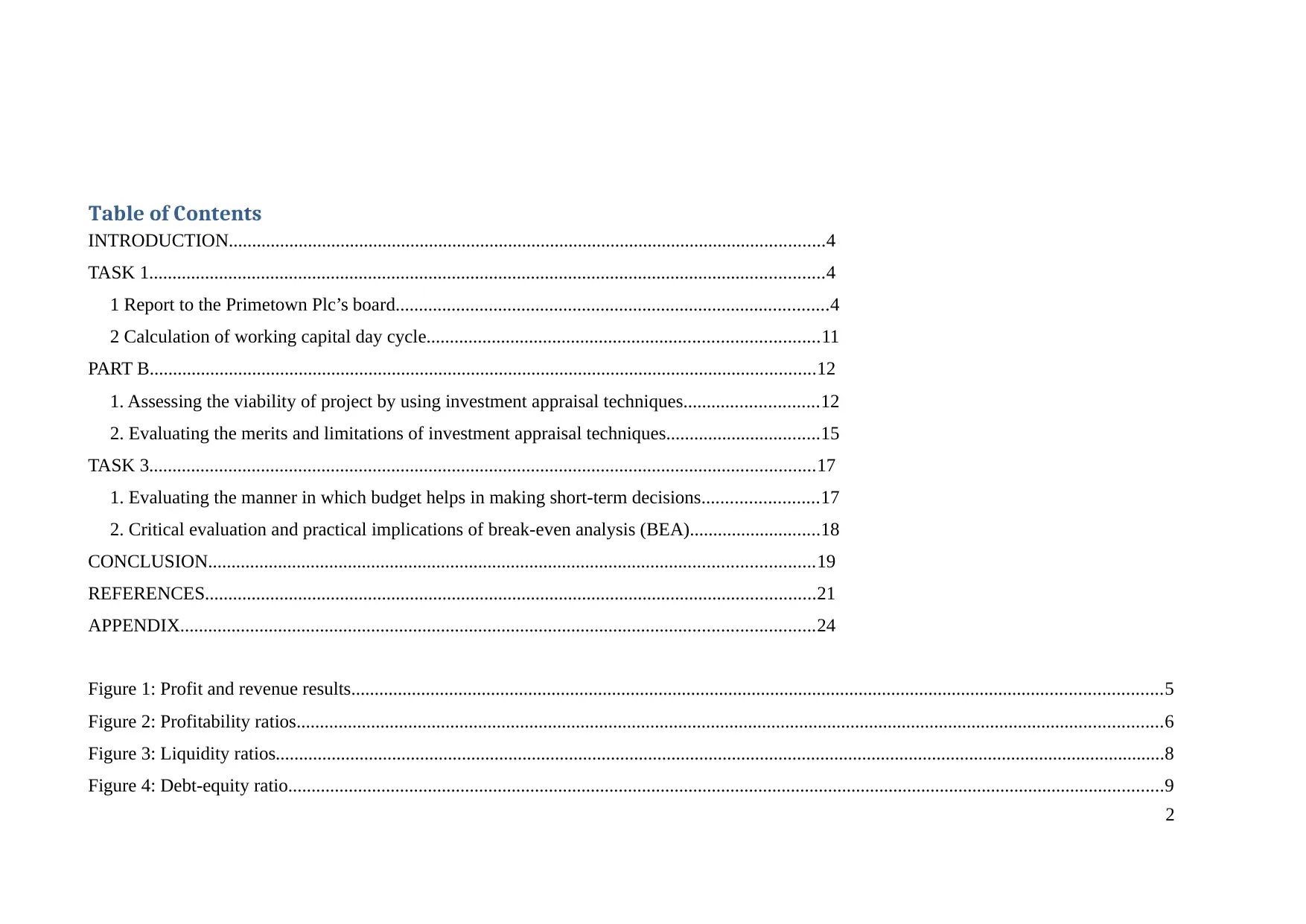
Table of Contents
INTRODUCTION................................................................................................................................4
TASK 1.................................................................................................................................................4
1 Report to the Primetown Plc’s board.............................................................................................4
2 Calculation of working capital day cycle....................................................................................11
PART B...............................................................................................................................................12
1. Assessing the viability of project by using investment appraisal techniques.............................12
2. Evaluating the merits and limitations of investment appraisal techniques.................................15
TASK 3...............................................................................................................................................17
1. Evaluating the manner in which budget helps in making short-term decisions.........................17
2. Critical evaluation and practical implications of break-even analysis (BEA)............................18
CONCLUSION..................................................................................................................................19
REFERENCES...................................................................................................................................21
APPENDIX........................................................................................................................................24
Figure 1: Profit and revenue results..............................................................................................................................................................................5
Figure 2: Profitability ratios..........................................................................................................................................................................................6
Figure 3: Liquidity ratios...............................................................................................................................................................................................8
Figure 4: Debt-equity ratio............................................................................................................................................................................................9
2
INTRODUCTION................................................................................................................................4
TASK 1.................................................................................................................................................4
1 Report to the Primetown Plc’s board.............................................................................................4
2 Calculation of working capital day cycle....................................................................................11
PART B...............................................................................................................................................12
1. Assessing the viability of project by using investment appraisal techniques.............................12
2. Evaluating the merits and limitations of investment appraisal techniques.................................15
TASK 3...............................................................................................................................................17
1. Evaluating the manner in which budget helps in making short-term decisions.........................17
2. Critical evaluation and practical implications of break-even analysis (BEA)............................18
CONCLUSION..................................................................................................................................19
REFERENCES...................................................................................................................................21
APPENDIX........................................................................................................................................24
Figure 1: Profit and revenue results..............................................................................................................................................................................5
Figure 2: Profitability ratios..........................................................................................................................................................................................6
Figure 3: Liquidity ratios...............................................................................................................................................................................................8
Figure 4: Debt-equity ratio............................................................................................................................................................................................9
2
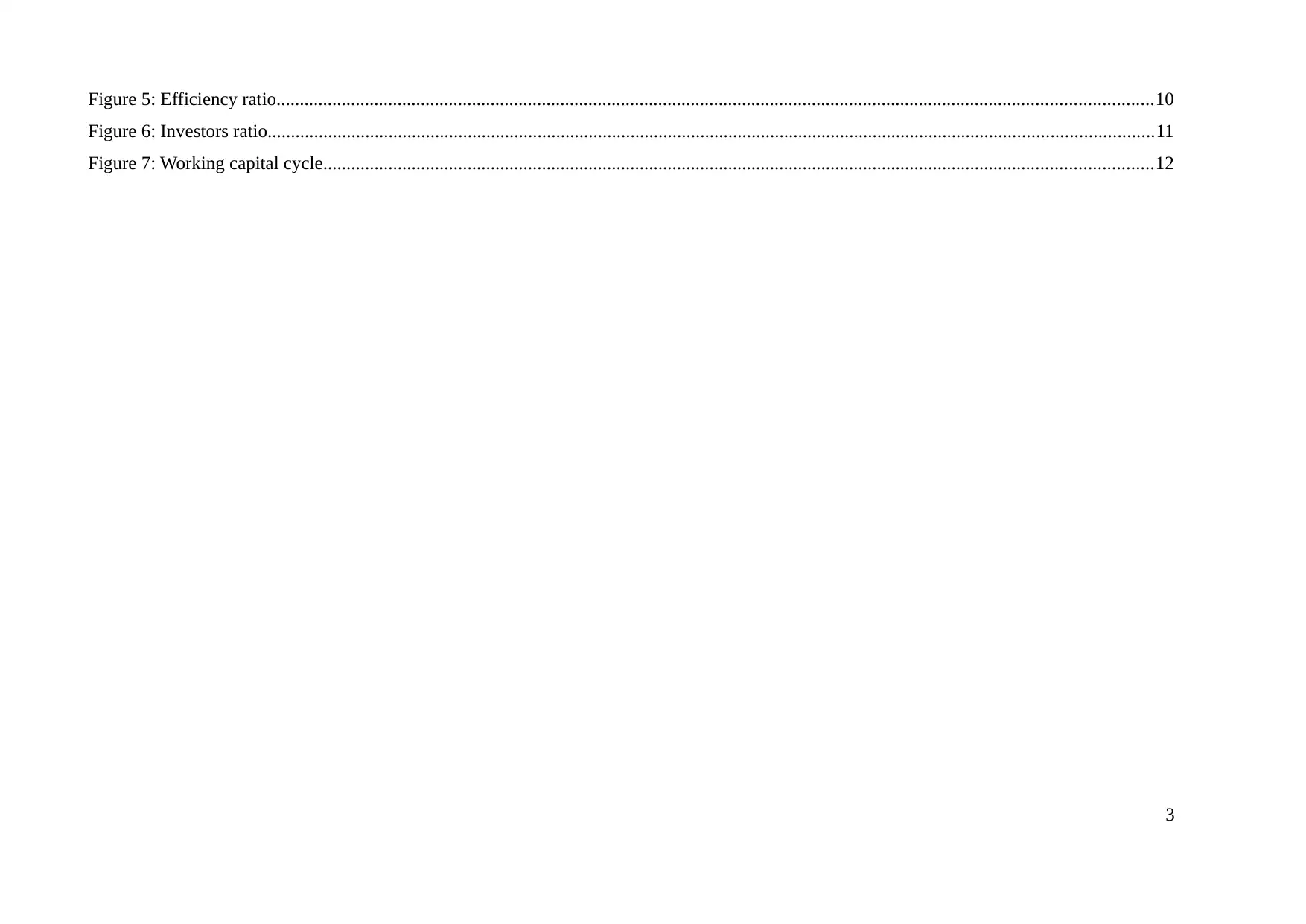
Figure 5: Efficiency ratio............................................................................................................................................................................................10
Figure 6: Investors ratio..............................................................................................................................................................................................11
Figure 7: Working capital cycle..................................................................................................................................................................................12
3
Figure 6: Investors ratio..............................................................................................................................................................................................11
Figure 7: Working capital cycle..................................................................................................................................................................................12
3
⊘ This is a preview!⊘
Do you want full access?
Subscribe today to unlock all pages.

Trusted by 1+ million students worldwide
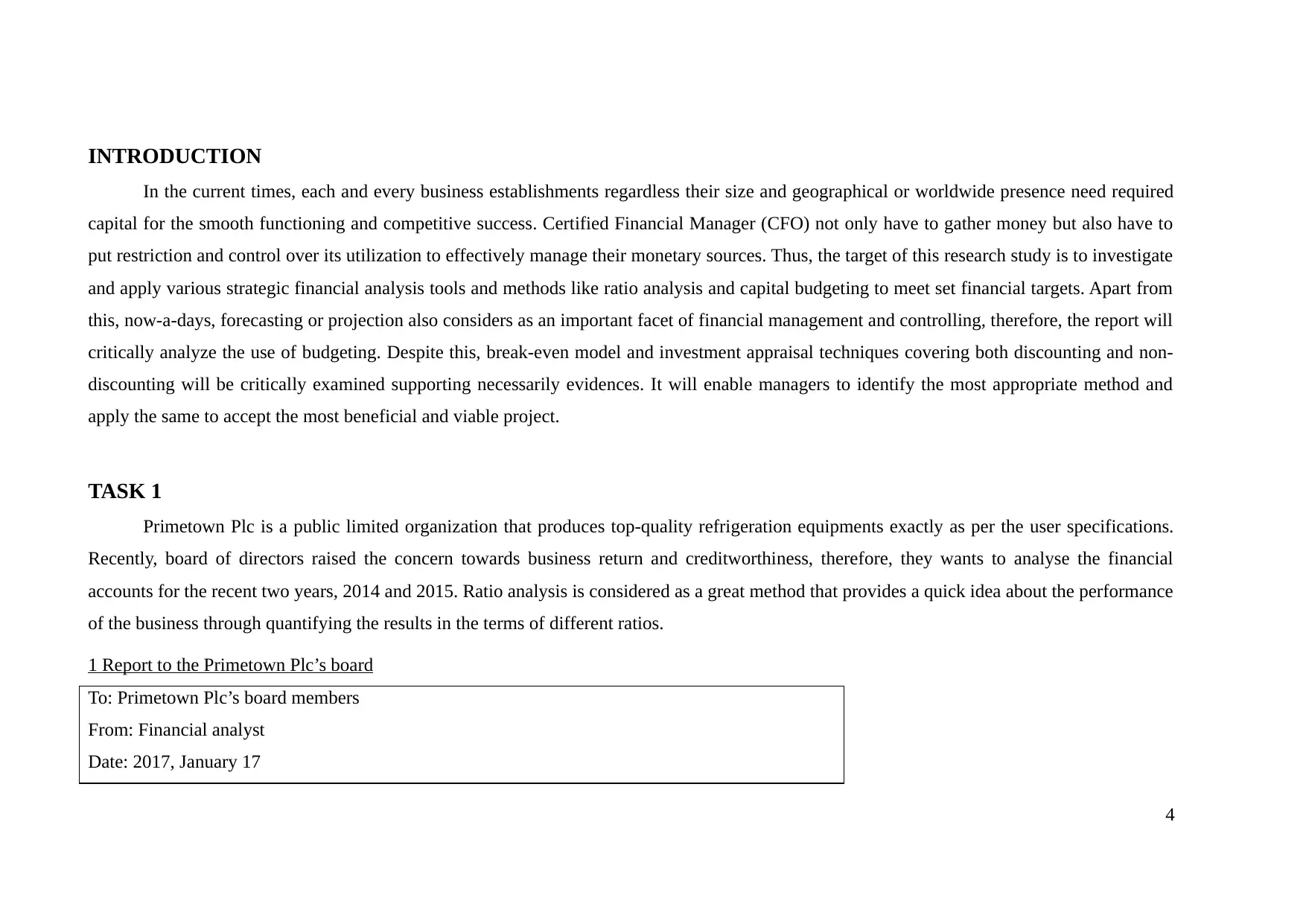
INTRODUCTION
In the current times, each and every business establishments regardless their size and geographical or worldwide presence need required
capital for the smooth functioning and competitive success. Certified Financial Manager (CFO) not only have to gather money but also have to
put restriction and control over its utilization to effectively manage their monetary sources. Thus, the target of this research study is to investigate
and apply various strategic financial analysis tools and methods like ratio analysis and capital budgeting to meet set financial targets. Apart from
this, now-a-days, forecasting or projection also considers as an important facet of financial management and controlling, therefore, the report will
critically analyze the use of budgeting. Despite this, break-even model and investment appraisal techniques covering both discounting and non-
discounting will be critically examined supporting necessarily evidences. It will enable managers to identify the most appropriate method and
apply the same to accept the most beneficial and viable project.
TASK 1
Primetown Plc is a public limited organization that produces top-quality refrigeration equipments exactly as per the user specifications.
Recently, board of directors raised the concern towards business return and creditworthiness, therefore, they wants to analyse the financial
accounts for the recent two years, 2014 and 2015. Ratio analysis is considered as a great method that provides a quick idea about the performance
of the business through quantifying the results in the terms of different ratios.
1 Report to the Primetown Plc’s board
To: Primetown Plc’s board members
From: Financial analyst
Date: 2017, January 17
4
In the current times, each and every business establishments regardless their size and geographical or worldwide presence need required
capital for the smooth functioning and competitive success. Certified Financial Manager (CFO) not only have to gather money but also have to
put restriction and control over its utilization to effectively manage their monetary sources. Thus, the target of this research study is to investigate
and apply various strategic financial analysis tools and methods like ratio analysis and capital budgeting to meet set financial targets. Apart from
this, now-a-days, forecasting or projection also considers as an important facet of financial management and controlling, therefore, the report will
critically analyze the use of budgeting. Despite this, break-even model and investment appraisal techniques covering both discounting and non-
discounting will be critically examined supporting necessarily evidences. It will enable managers to identify the most appropriate method and
apply the same to accept the most beneficial and viable project.
TASK 1
Primetown Plc is a public limited organization that produces top-quality refrigeration equipments exactly as per the user specifications.
Recently, board of directors raised the concern towards business return and creditworthiness, therefore, they wants to analyse the financial
accounts for the recent two years, 2014 and 2015. Ratio analysis is considered as a great method that provides a quick idea about the performance
of the business through quantifying the results in the terms of different ratios.
1 Report to the Primetown Plc’s board
To: Primetown Plc’s board members
From: Financial analyst
Date: 2017, January 17
4
Paraphrase This Document
Need a fresh take? Get an instant paraphrase of this document with our AI Paraphraser
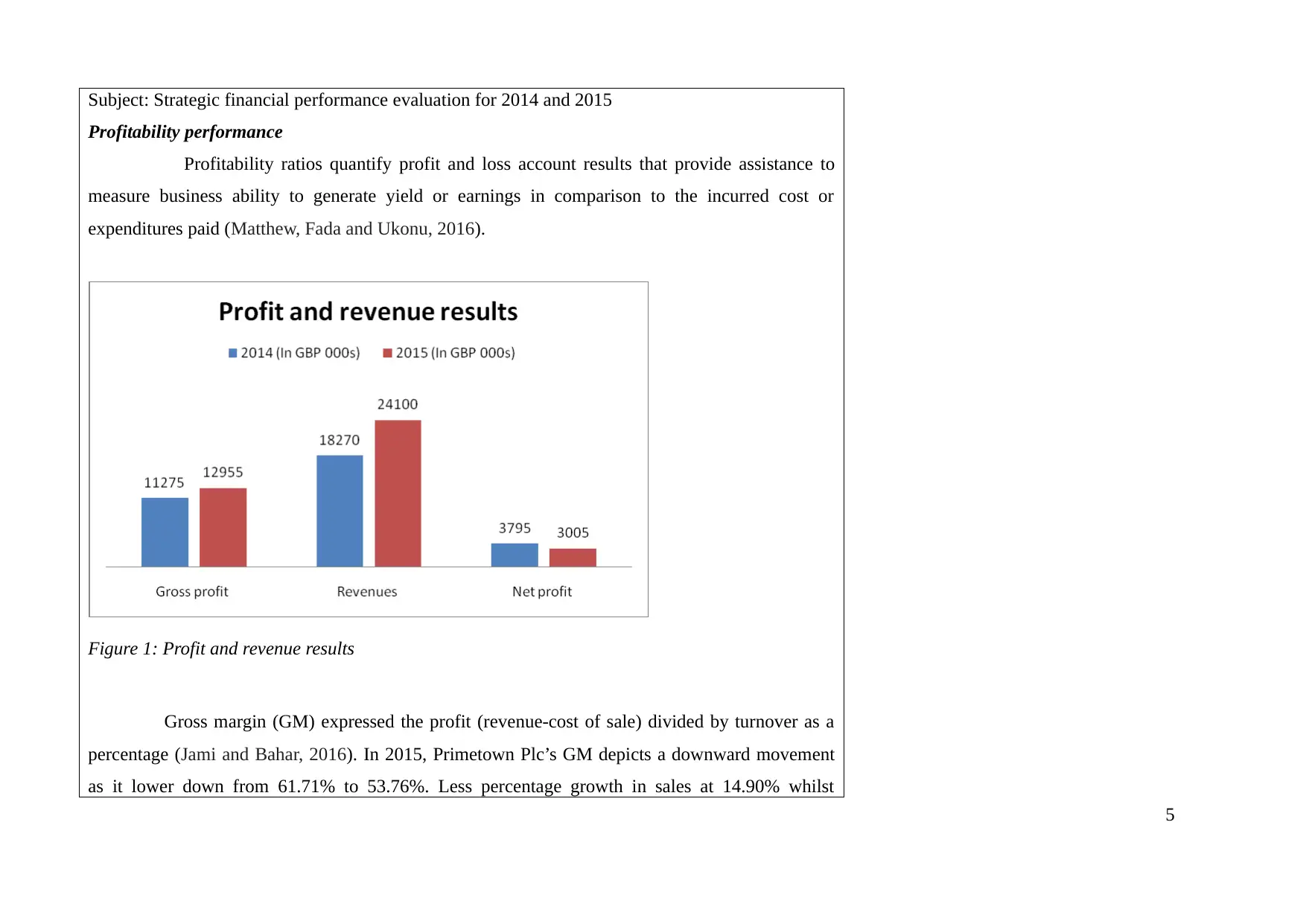
Subject: Strategic financial performance evaluation for 2014 and 2015
Profitability performance
Profitability ratios quantify profit and loss account results that provide assistance to
measure business ability to generate yield or earnings in comparison to the incurred cost or
expenditures paid (Matthew, Fada and Ukonu, 2016).
Figure 1: Profit and revenue results
Gross margin (GM) expressed the profit (revenue-cost of sale) divided by turnover as a
percentage (Jami and Bahar, 2016). In 2015, Primetown Plc’s GM depicts a downward movement
as it lower down from 61.71% to 53.76%. Less percentage growth in sales at 14.90% whilst
5
Profitability performance
Profitability ratios quantify profit and loss account results that provide assistance to
measure business ability to generate yield or earnings in comparison to the incurred cost or
expenditures paid (Matthew, Fada and Ukonu, 2016).
Figure 1: Profit and revenue results
Gross margin (GM) expressed the profit (revenue-cost of sale) divided by turnover as a
percentage (Jami and Bahar, 2016). In 2015, Primetown Plc’s GM depicts a downward movement
as it lower down from 61.71% to 53.76%. Less percentage growth in sales at 14.90% whilst
5
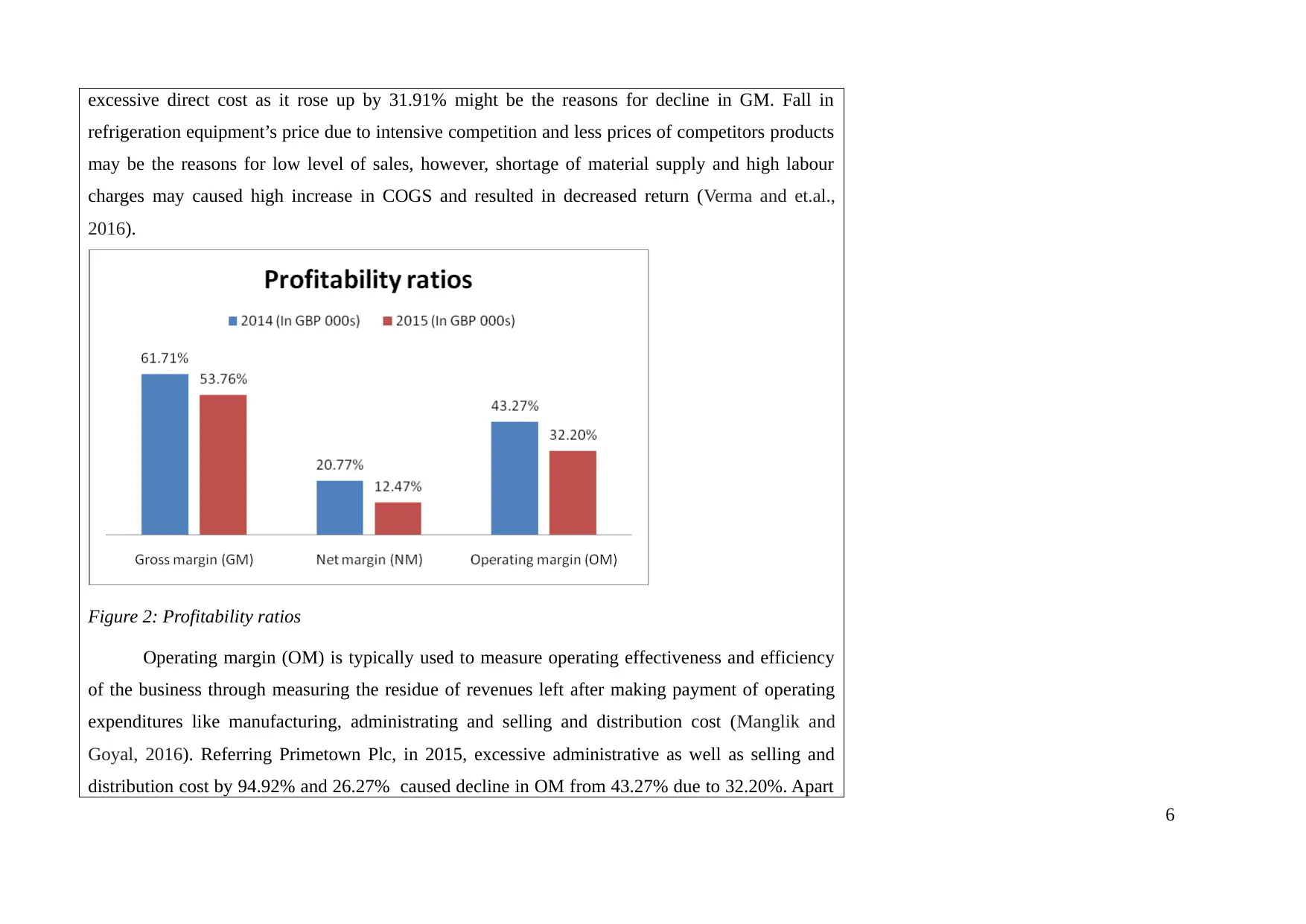
excessive direct cost as it rose up by 31.91% might be the reasons for decline in GM. Fall in
refrigeration equipment’s price due to intensive competition and less prices of competitors products
may be the reasons for low level of sales, however, shortage of material supply and high labour
charges may caused high increase in COGS and resulted in decreased return (Verma and et.al.,
2016).
Figure 2: Profitability ratios
Operating margin (OM) is typically used to measure operating effectiveness and efficiency
of the business through measuring the residue of revenues left after making payment of operating
expenditures like manufacturing, administrating and selling and distribution cost (Manglik and
Goyal, 2016). Referring Primetown Plc, in 2015, excessive administrative as well as selling and
distribution cost by 94.92% and 26.27% caused decline in OM from 43.27% due to 32.20%. Apart
6
refrigeration equipment’s price due to intensive competition and less prices of competitors products
may be the reasons for low level of sales, however, shortage of material supply and high labour
charges may caused high increase in COGS and resulted in decreased return (Verma and et.al.,
2016).
Figure 2: Profitability ratios
Operating margin (OM) is typically used to measure operating effectiveness and efficiency
of the business through measuring the residue of revenues left after making payment of operating
expenditures like manufacturing, administrating and selling and distribution cost (Manglik and
Goyal, 2016). Referring Primetown Plc, in 2015, excessive administrative as well as selling and
distribution cost by 94.92% and 26.27% caused decline in OM from 43.27% due to 32.20%. Apart
6
⊘ This is a preview!⊘
Do you want full access?
Subscribe today to unlock all pages.

Trusted by 1+ million students worldwide
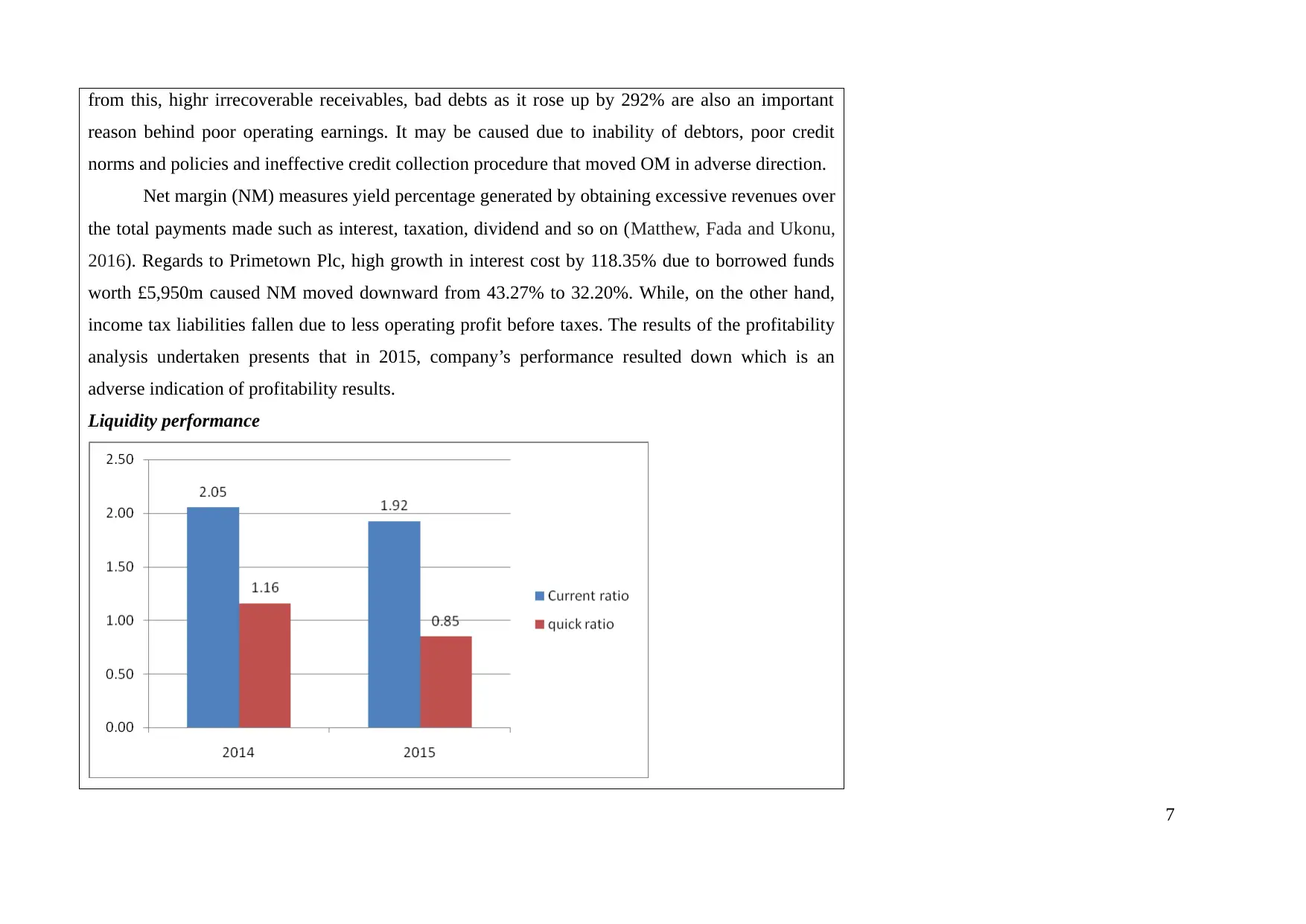
from this, highr irrecoverable receivables, bad debts as it rose up by 292% are also an important
reason behind poor operating earnings. It may be caused due to inability of debtors, poor credit
norms and policies and ineffective credit collection procedure that moved OM in adverse direction.
Net margin (NM) measures yield percentage generated by obtaining excessive revenues over
the total payments made such as interest, taxation, dividend and so on (Matthew, Fada and Ukonu,
2016). Regards to Primetown Plc, high growth in interest cost by 118.35% due to borrowed funds
worth £5,950m caused NM moved downward from 43.27% to 32.20%. While, on the other hand,
income tax liabilities fallen due to less operating profit before taxes. The results of the profitability
analysis undertaken presents that in 2015, company’s performance resulted down which is an
adverse indication of profitability results.
Liquidity performance
7
reason behind poor operating earnings. It may be caused due to inability of debtors, poor credit
norms and policies and ineffective credit collection procedure that moved OM in adverse direction.
Net margin (NM) measures yield percentage generated by obtaining excessive revenues over
the total payments made such as interest, taxation, dividend and so on (Matthew, Fada and Ukonu,
2016). Regards to Primetown Plc, high growth in interest cost by 118.35% due to borrowed funds
worth £5,950m caused NM moved downward from 43.27% to 32.20%. While, on the other hand,
income tax liabilities fallen due to less operating profit before taxes. The results of the profitability
analysis undertaken presents that in 2015, company’s performance resulted down which is an
adverse indication of profitability results.
Liquidity performance
7
Paraphrase This Document
Need a fresh take? Get an instant paraphrase of this document with our AI Paraphraser
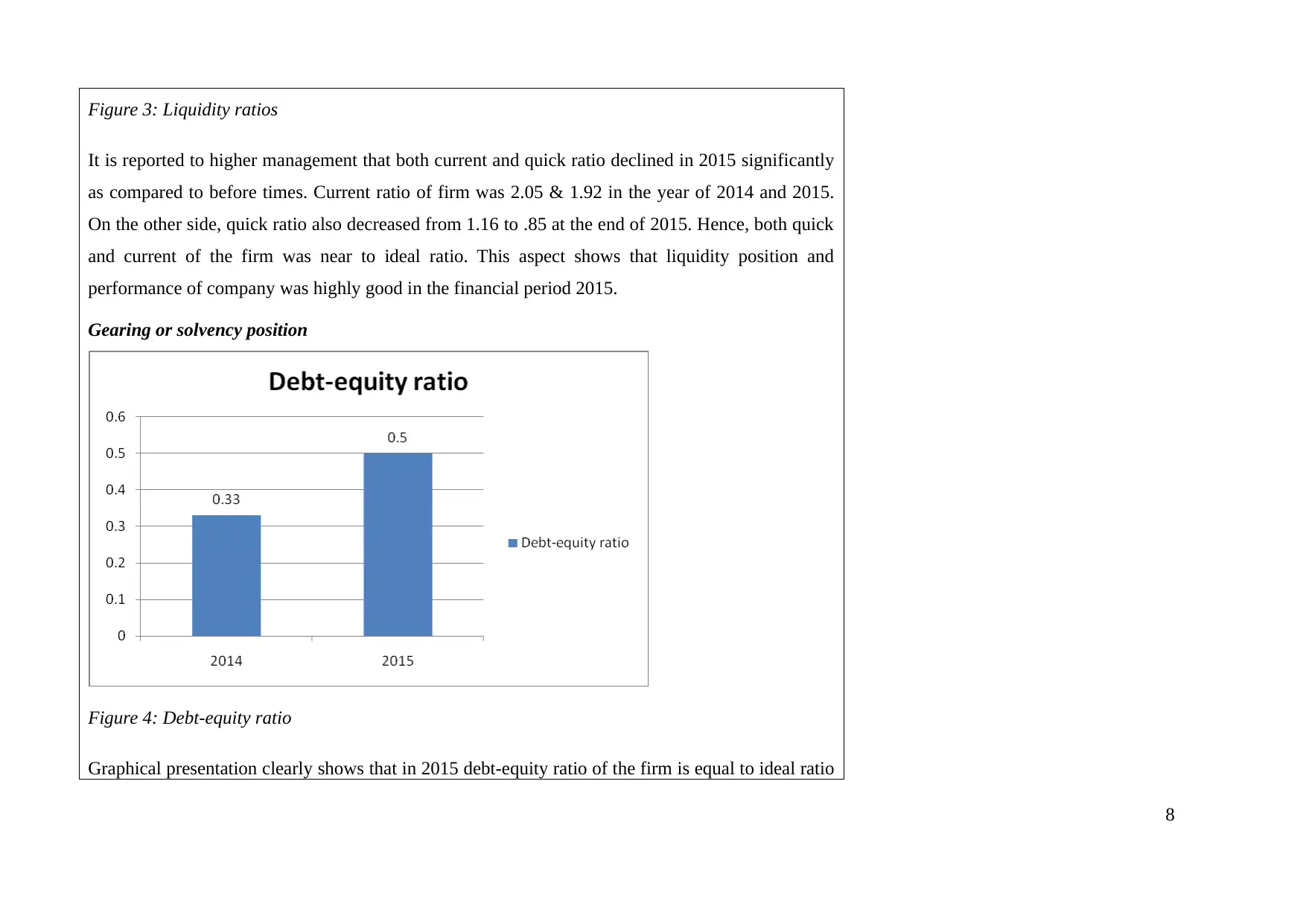
Figure 3: Liquidity ratios
It is reported to higher management that both current and quick ratio declined in 2015 significantly
as compared to before times. Current ratio of firm was 2.05 & 1.92 in the year of 2014 and 2015.
On the other side, quick ratio also decreased from 1.16 to .85 at the end of 2015. Hence, both quick
and current of the firm was near to ideal ratio. This aspect shows that liquidity position and
performance of company was highly good in the financial period 2015.
Gearing or solvency position
Figure 4: Debt-equity ratio
Graphical presentation clearly shows that in 2015 debt-equity ratio of the firm is equal to ideal ratio
8
It is reported to higher management that both current and quick ratio declined in 2015 significantly
as compared to before times. Current ratio of firm was 2.05 & 1.92 in the year of 2014 and 2015.
On the other side, quick ratio also decreased from 1.16 to .85 at the end of 2015. Hence, both quick
and current of the firm was near to ideal ratio. This aspect shows that liquidity position and
performance of company was highly good in the financial period 2015.
Gearing or solvency position
Figure 4: Debt-equity ratio
Graphical presentation clearly shows that in 2015 debt-equity ratio of the firm is equal to ideal ratio
8
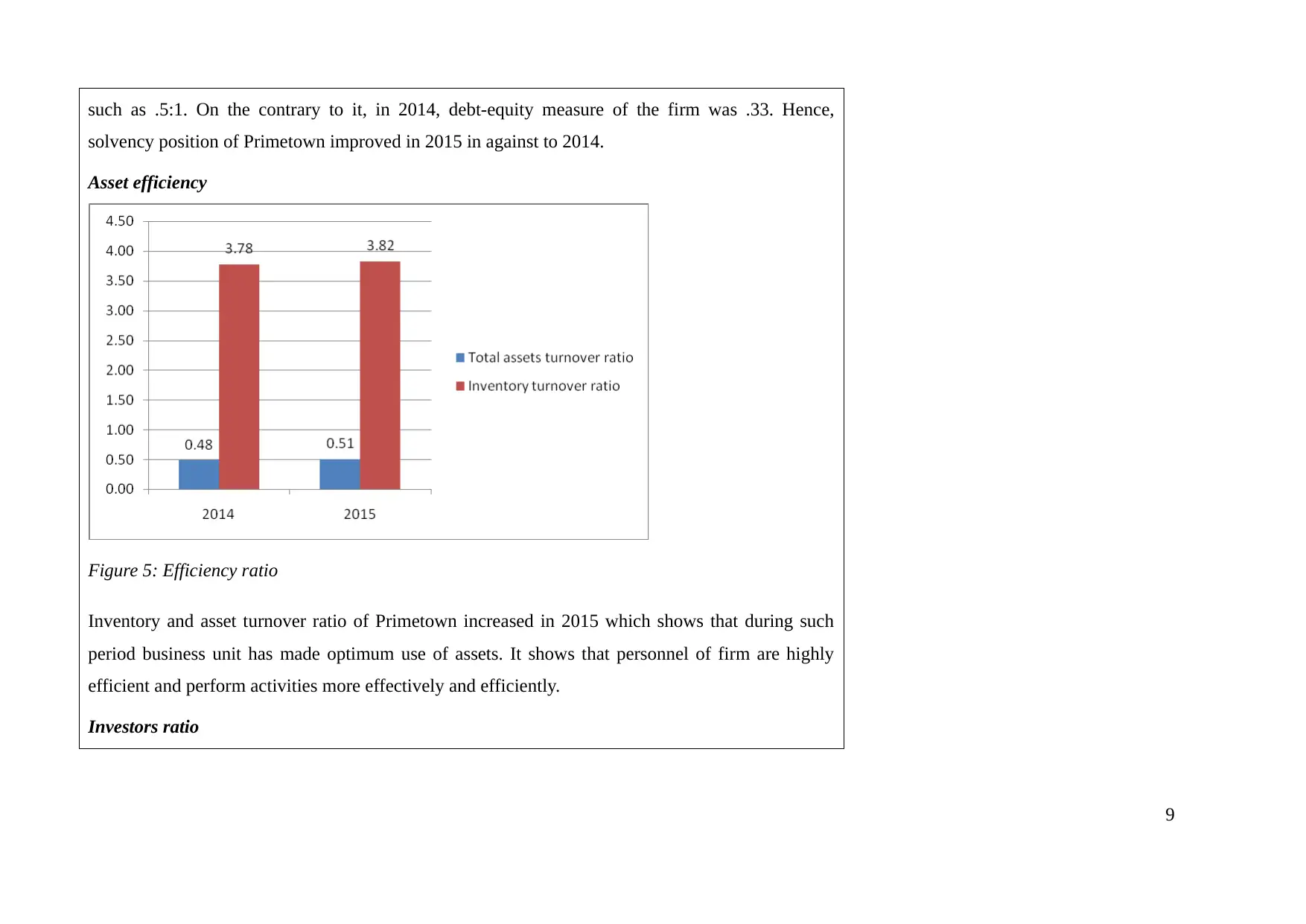
such as .5:1. On the contrary to it, in 2014, debt-equity measure of the firm was .33. Hence,
solvency position of Primetown improved in 2015 in against to 2014.
Asset efficiency
Figure 5: Efficiency ratio
Inventory and asset turnover ratio of Primetown increased in 2015 which shows that during such
period business unit has made optimum use of assets. It shows that personnel of firm are highly
efficient and perform activities more effectively and efficiently.
Investors ratio
9
solvency position of Primetown improved in 2015 in against to 2014.
Asset efficiency
Figure 5: Efficiency ratio
Inventory and asset turnover ratio of Primetown increased in 2015 which shows that during such
period business unit has made optimum use of assets. It shows that personnel of firm are highly
efficient and perform activities more effectively and efficiently.
Investors ratio
9
⊘ This is a preview!⊘
Do you want full access?
Subscribe today to unlock all pages.

Trusted by 1+ million students worldwide
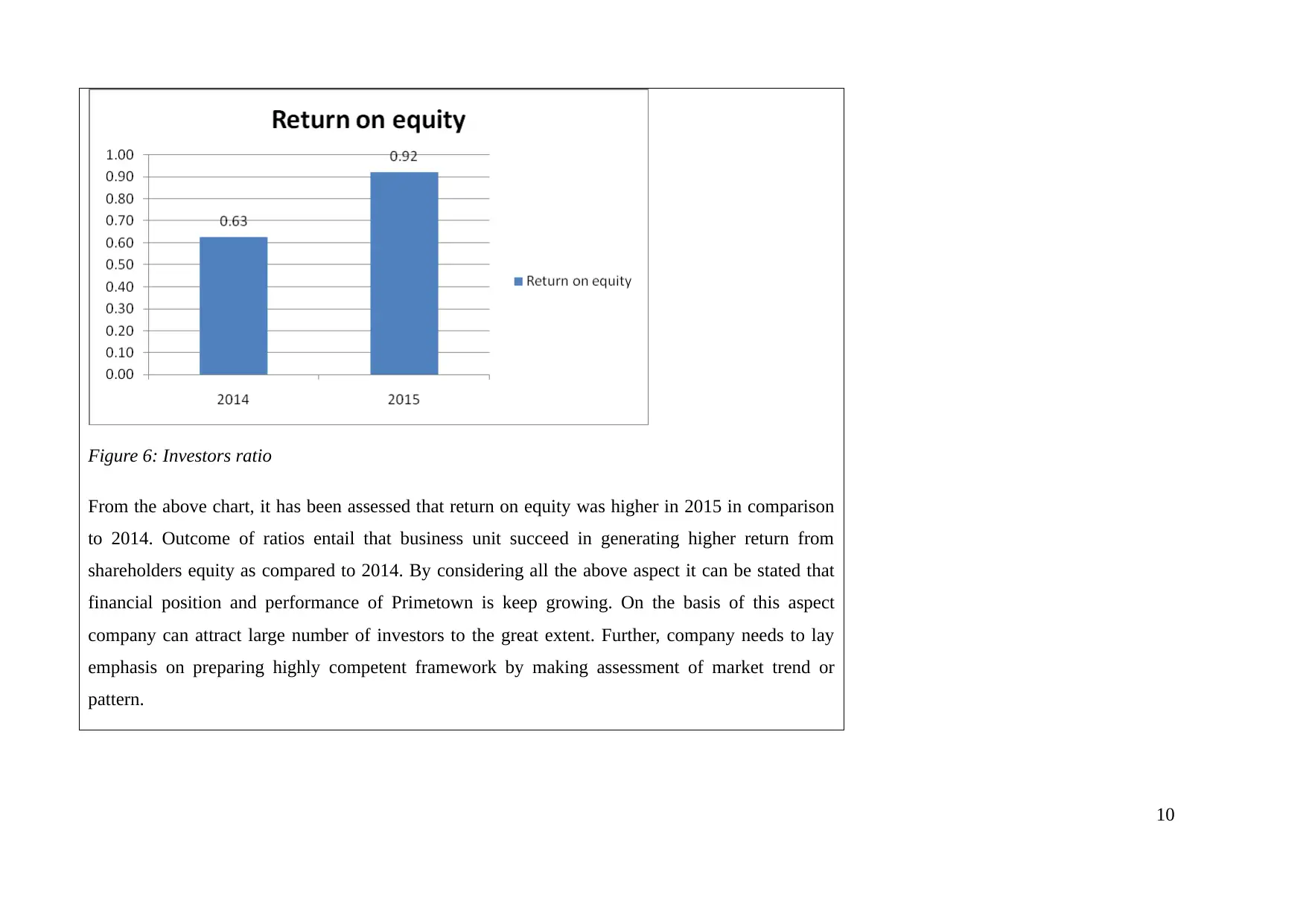
Figure 6: Investors ratio
From the above chart, it has been assessed that return on equity was higher in 2015 in comparison
to 2014. Outcome of ratios entail that business unit succeed in generating higher return from
shareholders equity as compared to 2014. By considering all the above aspect it can be stated that
financial position and performance of Primetown is keep growing. On the basis of this aspect
company can attract large number of investors to the great extent. Further, company needs to lay
emphasis on preparing highly competent framework by making assessment of market trend or
pattern.
10
From the above chart, it has been assessed that return on equity was higher in 2015 in comparison
to 2014. Outcome of ratios entail that business unit succeed in generating higher return from
shareholders equity as compared to 2014. By considering all the above aspect it can be stated that
financial position and performance of Primetown is keep growing. On the basis of this aspect
company can attract large number of investors to the great extent. Further, company needs to lay
emphasis on preparing highly competent framework by making assessment of market trend or
pattern.
10
Paraphrase This Document
Need a fresh take? Get an instant paraphrase of this document with our AI Paraphraser
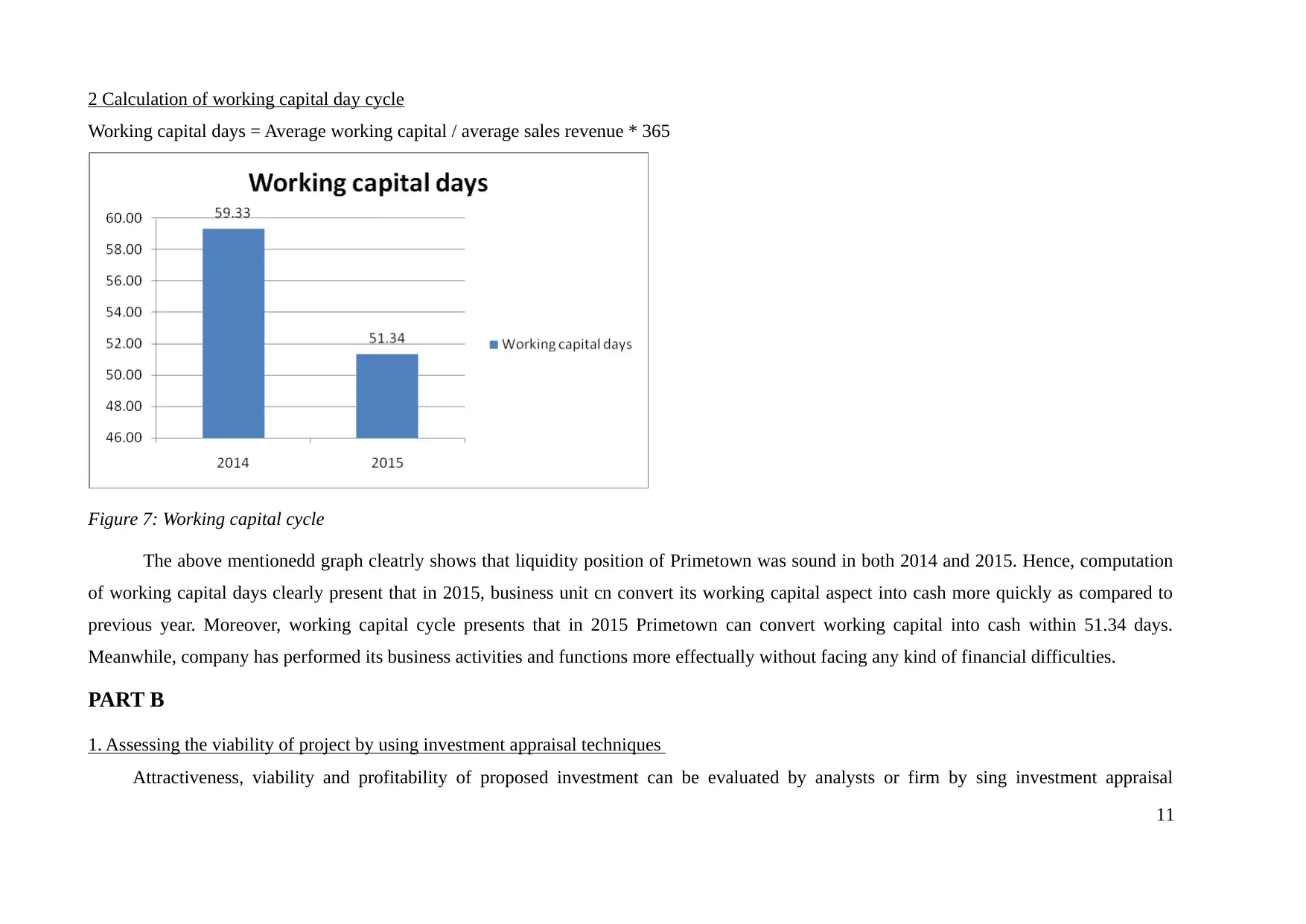
2 Calculation of working capital day cycle
Working capital days = Average working capital / average sales revenue * 365
Figure 7: Working capital cycle
The above mentionedd graph cleatrly shows that liquidity position of Primetown was sound in both 2014 and 2015. Hence, computation
of working capital days clearly present that in 2015, business unit cn convert its working capital aspect into cash more quickly as compared to
previous year. Moreover, working capital cycle presents that in 2015 Primetown can convert working capital into cash within 51.34 days.
Meanwhile, company has performed its business activities and functions more effectually without facing any kind of financial difficulties.
PART B
1. Assessing the viability of project by using investment appraisal techniques
Attractiveness, viability and profitability of proposed investment can be evaluated by analysts or firm by sing investment appraisal
11
Working capital days = Average working capital / average sales revenue * 365
Figure 7: Working capital cycle
The above mentionedd graph cleatrly shows that liquidity position of Primetown was sound in both 2014 and 2015. Hence, computation
of working capital days clearly present that in 2015, business unit cn convert its working capital aspect into cash more quickly as compared to
previous year. Moreover, working capital cycle presents that in 2015 Primetown can convert working capital into cash within 51.34 days.
Meanwhile, company has performed its business activities and functions more effectually without facing any kind of financial difficulties.
PART B
1. Assessing the viability of project by using investment appraisal techniques
Attractiveness, viability and profitability of proposed investment can be evaluated by analysts or firm by sing investment appraisal
11
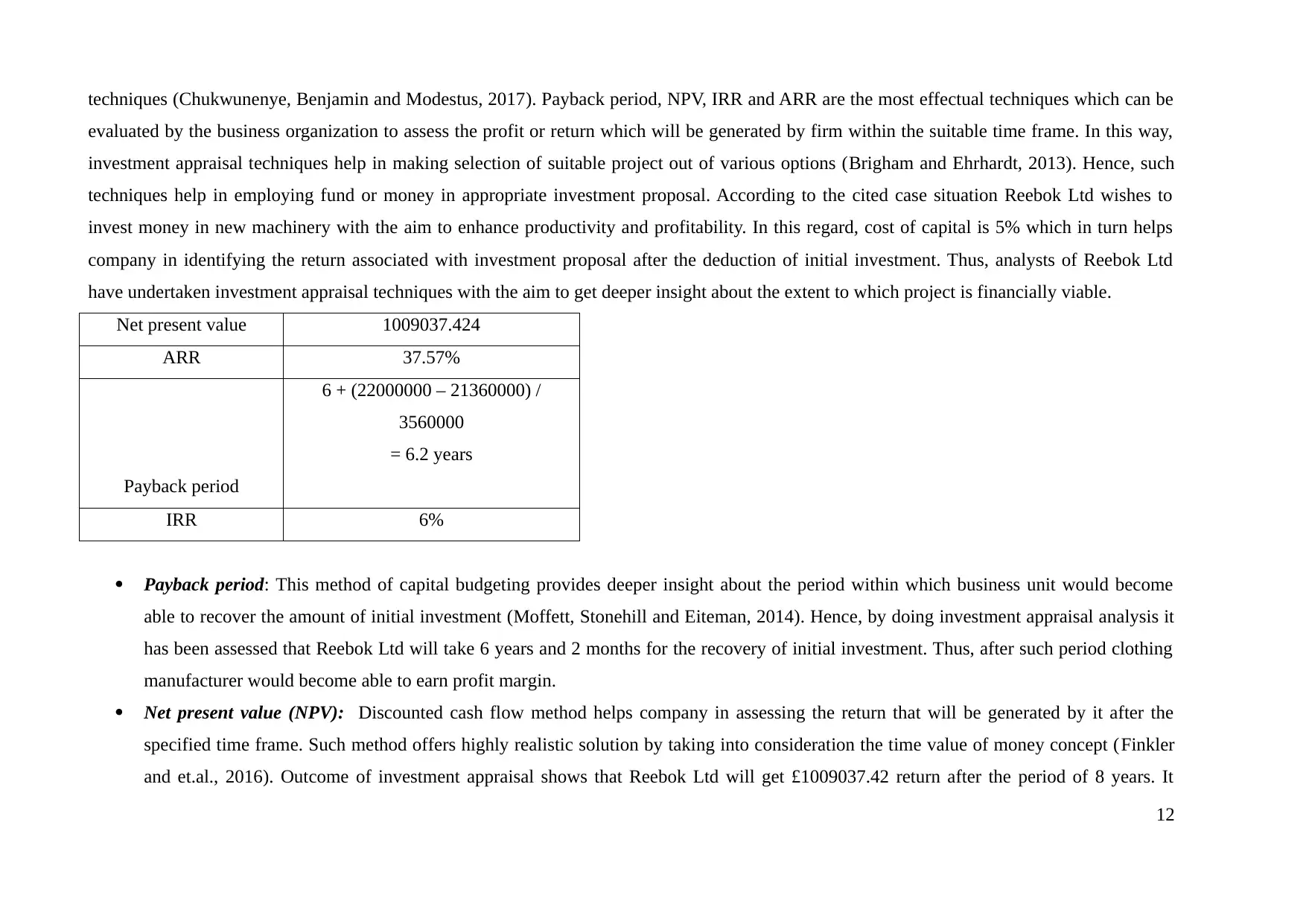
techniques (Chukwunenye, Benjamin and Modestus, 2017). Payback period, NPV, IRR and ARR are the most effectual techniques which can be
evaluated by the business organization to assess the profit or return which will be generated by firm within the suitable time frame. In this way,
investment appraisal techniques help in making selection of suitable project out of various options (Brigham and Ehrhardt, 2013). Hence, such
techniques help in employing fund or money in appropriate investment proposal. According to the cited case situation Reebok Ltd wishes to
invest money in new machinery with the aim to enhance productivity and profitability. In this regard, cost of capital is 5% which in turn helps
company in identifying the return associated with investment proposal after the deduction of initial investment. Thus, analysts of Reebok Ltd
have undertaken investment appraisal techniques with the aim to get deeper insight about the extent to which project is financially viable.
Net present value 1009037.424
ARR 37.57%
Payback period
6 + (22000000 – 21360000) /
3560000
= 6.2 years
IRR 6%
Payback period: This method of capital budgeting provides deeper insight about the period within which business unit would become
able to recover the amount of initial investment (Moffett, Stonehill and Eiteman, 2014). Hence, by doing investment appraisal analysis it
has been assessed that Reebok Ltd will take 6 years and 2 months for the recovery of initial investment. Thus, after such period clothing
manufacturer would become able to earn profit margin.
Net present value (NPV): Discounted cash flow method helps company in assessing the return that will be generated by it after the
specified time frame. Such method offers highly realistic solution by taking into consideration the time value of money concept (Finkler
and et.al., 2016). Outcome of investment appraisal shows that Reebok Ltd will get £1009037.42 return after the period of 8 years. It
12
evaluated by the business organization to assess the profit or return which will be generated by firm within the suitable time frame. In this way,
investment appraisal techniques help in making selection of suitable project out of various options (Brigham and Ehrhardt, 2013). Hence, such
techniques help in employing fund or money in appropriate investment proposal. According to the cited case situation Reebok Ltd wishes to
invest money in new machinery with the aim to enhance productivity and profitability. In this regard, cost of capital is 5% which in turn helps
company in identifying the return associated with investment proposal after the deduction of initial investment. Thus, analysts of Reebok Ltd
have undertaken investment appraisal techniques with the aim to get deeper insight about the extent to which project is financially viable.
Net present value 1009037.424
ARR 37.57%
Payback period
6 + (22000000 – 21360000) /
3560000
= 6.2 years
IRR 6%
Payback period: This method of capital budgeting provides deeper insight about the period within which business unit would become
able to recover the amount of initial investment (Moffett, Stonehill and Eiteman, 2014). Hence, by doing investment appraisal analysis it
has been assessed that Reebok Ltd will take 6 years and 2 months for the recovery of initial investment. Thus, after such period clothing
manufacturer would become able to earn profit margin.
Net present value (NPV): Discounted cash flow method helps company in assessing the return that will be generated by it after the
specified time frame. Such method offers highly realistic solution by taking into consideration the time value of money concept (Finkler
and et.al., 2016). Outcome of investment appraisal shows that Reebok Ltd will get £1009037.42 return after the period of 8 years. It
12
⊘ This is a preview!⊘
Do you want full access?
Subscribe today to unlock all pages.

Trusted by 1+ million students worldwide
1 out of 25
Related Documents
Your All-in-One AI-Powered Toolkit for Academic Success.
+13062052269
info@desklib.com
Available 24*7 on WhatsApp / Email
![[object Object]](/_next/static/media/star-bottom.7253800d.svg)
Unlock your academic potential
Copyright © 2020–2025 A2Z Services. All Rights Reserved. Developed and managed by ZUCOL.





